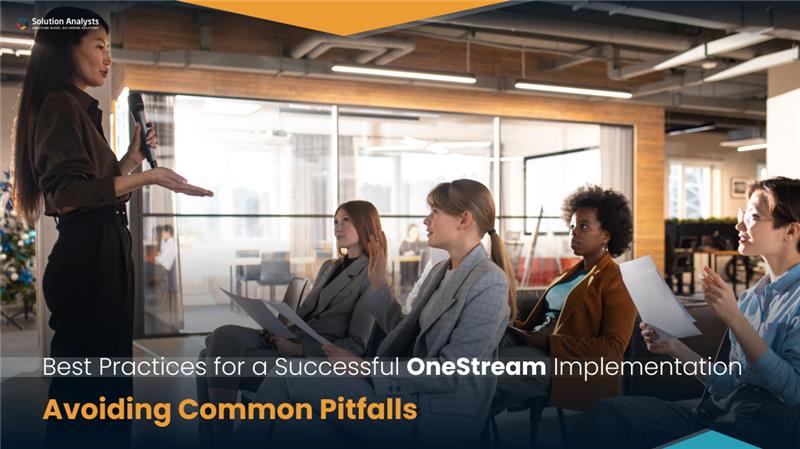
Table of Contents
Introduction
Implementing OneStream for financial planning, consolidation, and reporting can transform enterprise performance management. However, achieving a seamless implementation requires strategic planning, technological alignment, and an awareness of potential pitfalls. In this blog, we’ll explore the best practices for a OneStream implementation while incorporating the latest advancements in financial technology.
Deploying OneStream, a powerful platform for financial consolidation, planning, and reporting, is much like setting out on a cross-country road trip. With the right roadmap, a well-maintained vehicle, and a few essentials packed, you’re set for success. But if you take a wrong turn, neglect maintenance, or fail to prepare for detours, you could end up stranded. So, how do you ensure your OneStream implementation runs smoothly from start to finish? Let’s dive into the best practices for a OneStream implementation that pave the way for success—and the common pitfalls you’ll want to avoid.
Best practices for a OneStream implementation
1. Set Well-Defined Business Goals with Measurable Outcomes
A successful OneStream implementation starts with aligning finance, IT, and leadership around clear, measurable goals—whether it’s streamlining financial consolidation, accelerating reporting, integrating budgeting, or utilizing AI-driven forecasting and real-time analytics. Setting well-defined objectives with measurable KPIs ensures alignment, prevents scope creep, and maximizes business value through automation and focus.
Avoid This Pitfall: Jumping into implementation without a clear roadmap can lead to misalignment between business needs and system capabilities, resulting in inefficiencies and rework.
2. Engage Cross-Functional Stakeholders Early
A strong, cross-functional team is crucial from the start. Engaging finance, IT, compliance, and operations helps define workflows, assess technical feasibility, and meet regulatory requirements. A mix of internal experts, external consultants, and end-user advocates brings both institutional knowledge and technical expertise. Leadership buy-in and open communication are key to driving success.
Avoid This Pitfall: Failing to involve key stakeholders can result in user resistance, misconfigured workflows, and data silos.
3. Leverage AI and Automation for Efficiency
OneStream continuously evolves with AI-powered predictive analytics, intelligent automation, and machine learning algorithms. Utilizing these advanced features enhances efficiency, improves forecasting accuracy, and reduces the need for manual intervention. The best practices for a OneStream implementation include integrating these tools to drive automation and optimize performance.
Avoid This Pitfall: Sticking to outdated methodologies instead of taking advantage of automation and AI-driven insights can limit OneStream’s potential.
4. Prioritize Data Governance, Security, and Compliance
Establishing strong data governance frameworks, enforcing role-based access controls, and ensuring compliance with financial standards (IFRS, GAAP, SOX) are essential. Clearly defining data ownership and implementing automated validation checks helps prevent discrepancies and security risks. Organizations following the best practices for a OneStream implementation prioritize data integrity to maintain compliance and enhance financial decision-making.
Avoid This Pitfall: Weak data governance can lead to inaccurate reporting, regulatory non-compliance, and security vulnerabilities.
5. Maximize Scalability and Cloud Capabilities
OneStream’s cloud-based deployment options enable organizations to scale their financial operations efficiently. Utilizing API integrations, real-time data processing, and extended analytics dashboards enhances decision-making and improves overall system performance. One of the best practices for a OneStream implementation is ensuring businesses take full advantage of these cloud and integration capabilities.
Avoid This Pitfall: Failing to leverage cloud functionalities and advanced integration options can restrict scalability and efficiency.
6. Adopt an Agile, Iterative Implementation Approach
Instead of rolling out everything at once, implement OneStream in phases—prioritizing critical functionalities like financial close, reporting, and advanced analytics. Iterative testing and feedback loops ensure greater flexibility and adaptability, aligning with the best practices for a OneStream implementation.
Avoid This Pitfall: A big-bang approach can overwhelm users and increase implementation risks.
7. Invest in Continuous Learning and Training
Ensure end-users receive thorough training on OneStream’s latest features, AI-driven insights, and workflow automation. Hands-on workshops, real-time simulations, and digital training resources help drive adoption and maximize efficiency. Following the best practices for a OneStream implementation includes keeping teams updated with the latest OneStream advancements.
Avoid This Pitfall: Inadequate training can lead to poor adoption rates, underutilization of the platform, and inefficiencies.
8. Continuously Monitor and Optimize Performance
OneStream is a dynamic platform that requires ongoing performance monitoring and optimization. Leveraging real-time dashboards, anomaly detection, and AI-driven analytics helps identify inefficiencies and improve financial decision-making. One of the best practices for a OneStream implementation is maintaining a proactive approach to system monitoring and updates.
Avoid This Pitfall: Treating implementation as a one-time effort without ongoing optimization can result in stagnation and inefficiencies.
Conclusion
A successful OneStream implementation requires a well-planned strategy, technological alignment, and continuous innovation. By following the best practices for a OneStream implementation and proactively addressing challenges, organizations can unlock OneStream’s full potential—driving data-driven financial transformations.

Shruti Prajapati
Technical Project Manager
A results-driven Technical Project Manager with nearly a decade of experience in IT, specializing in Agile methodologies and end-to-end software development. Skilled in leading cross-functional teams, optimizing project workflows, and delivering high-impact solutions across mobile and web technologies. With expertise in domains such as IoT, E-Commerce, Healthcare, and Social platforms, She is passionate about driving innovation, efficiency, and success in every project.











 sales@solutionanalysts.com
sales@solutionanalysts.com biz.solutionanalysts
biz.solutionanalysts






